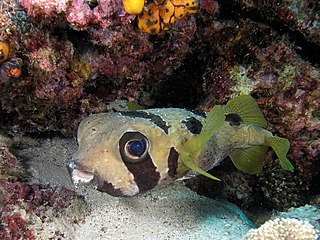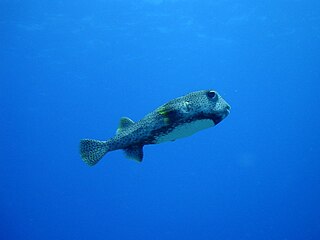
Tetraodontidae is a family of primarily marine and estuarine fish of the order Tetraodontiformes. The family includes many familiar species variously called pufferfish, puffers, balloonfish, blowfish, blowers, blowies, bubblefish, globefish, swellfish, toadfish, toadies, toadle, honey toads, sugar toads, and sea squab. They are morphologically similar to the closely related porcupinefish, which have large external spines. The scientific name refers to the four large teeth, fused into an upper and lower plate, which are used for crushing the hard shells of crustaceans and mollusks, their natural prey.

Porcupinefish are medium-to-large fish belonging to the family Diodontidae from the order Tetraodontiformes which are also commonly called blowfish and, sometimes, balloonfish and globefish. They are sometimes collectively called pufferfish, not to be confused with the morphologically similar and closely related Tetraodontidae, which are more commonly given this name.

The Tetraodontiformes are an order of highly derived ray-finned fish, also called the Plectognathi. Sometimes these are classified as a suborder of the order Perciformes. The Tetraodontiformes are represented by 10 extant families and at least 349 species overall; most are marine and dwell in and around tropical coral reefs, but a few species are found in freshwater streams and estuaries. They have no close relatives, and descend from a line of coral-dwelling species that emerged around 80 million years ago.

The ocean sunfish or common mola is one of the largest bony fish in the world. It was misidentified as the heaviest bony fish, which was actually a different species, Mola alexandrini. Adults typically weigh between 247 and 1,000 kg. The species is native to tropical and temperate waters around the world. It resembles a fish head without a tail, and its main body is flattened laterally. Sunfish can be as tall as they are long when their dorsal and ventral fins are extended.
Hemiramphidae is a family of fishes that are commonly called halfbeaks, spipe fish or spipefish. They are a geographically widespread and numerically abundant family of epipelagic fish inhabiting warm waters around the world. The halfbeaks are named for their distinctive jaws, in which the lower jaws are significantly longer than the upper jaws. The similar viviparous halfbeaks have often been included in this family.

Pelagic fish live in the pelagic zone of ocean or lake waters—being neither close to the bottom nor near the shore—in contrast with demersal fish that do live on or near the bottom, and reef fish that are associated with coral reefs.

The pelagic thresher is a species of thresher shark, family Alopiidae; this group of sharks is characterized by the greatly elongated upper lobes of their caudal fins. The pelagic thresher occurs in the tropical and subtropical waters of the Indian and Pacific Oceans, usually far from shore, but occasionally entering coastal habitats. It is often confused with the common thresher, even in professional publications, but can be distinguished by the dark, rather than white, color over the bases of its pectoral fins. The smallest of the three thresher species, the pelagic thresher typically measures 3 m (10 ft) long.

The yellow boxfish is a species of boxfish found in reefs throughout the Pacific Ocean and Indian Ocean as well as the southeastern Atlantic Ocean. Recorded occasionally since 2011 in the Levantine waters of the Mediterranean Sea which it likely entered via the Suez Canal, it is a species appreciated in the aquarium trade.

The black-blotched porcupinefish, also known as shortspine porcupinefish, is a member of the family Diodontidae. It is found in the tropical and subtropical waters of the Indo-Pacific on coral and rocky reefs and in inshore waters. Other names are the blotched porcupinefish and the brown-backed porcupinefish.

The spot-fin porcupinefish, also known as the spotted porcupinefish, black-spotted porcupinefish or simply porcupinefish, is a member of the family Diodontidae.

The long-spine porcupinefish, also known as the freckled porcupinefish among other vernacular names, is a species of marine fish in the family Diodontidae.

The slender-spined porcupine fish or globefish is a porcupinefish of the family Diodontidae, found in the waters of southern Australia, as far north as Port Jackson to Geraldton, Western Australia. It is most common in Port Phillip Bay and the coastal waters of Tasmania in shallow coastal waters and under manmade jetties. It is known to occur at a depth range of 1 to 70 m.

Porcupinefishes or balloonfishes, are any of the various species of the genus Diodon, the type genus of Diodontidae.

Ptychodus is a genus of extinct durophagous (shell-crushing) sharks from the Late Cretaceous. Fossils of Ptychodus teeth are found in many Late Cretaceous marine sediments. There are many species among the Ptychodus that have been uncovered on all the continents around the globe. Such species are Ptychodus mortoni, P. decurrens, P. marginalis, P. mammillaris, P. rugosus and P. latissimus to name a few. They died out approximately 85 million years ago. A large number of remains have been found in the former Western Interior Seaway. A 2016 publication found that Ptychodus are likely true sharks belonging to Selachimorpha, rather than hybodonts or batoids as previously thought. Their life history coincides with the typical life of many other large sharks: they lived relatively long lives and were slow growing and produced large offspring and small litters.

Chilomycterus reticulatus, the spotfin burrfish, spotted burrfish, Pacific burrfish, spotfin porcupinefish or few-spined porcupinefish, is a species of fish in the genus Chilomycterus, which is part of the porcupinefish family Diodontidae.

Cyclichthys orbicularis, known commonly as the Birdbeak burrfish among other vernacular names, is a species of marine fish in the family Diodontidae.

Diadema savignyi is a species of long-spined sea urchin belonging to the family Diadematidae. Common names include long-spined sea urchin, black longspine urchin and the banded diadem. It is native to the east coast of Africa, the Red Sea, the Indian Ocean and western Pacific Ocean. It was first described in 1829 by the French naturalist Jean Victoire Audouin. The specific epithet honours the French zoologist Marie Jules César Savigny who described many new marine species from the Mediterranean Sea and Red Sea. The type locality is Mauritius.
Canthigaster tyleri, also known as Tyler's toby, is a species of marine fish in the family Tetraodontidae.
Canthigaster figueiredoi, known as the Southern Atlantic sharpnose-puffer, is a species of marine fish in the family Tetraodontidae. It was first isolated from the east coast of South America, in the Atlantic Ocean.

Conchoderma virgatum is a species of goose barnacle in the family Lepadidae. It is a pelagic species found in open water in most of the world's oceans attached to drifting objects or marine organisms.
















